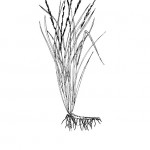Maidencane
Panicum hemitomon Schult.
Poaceae
Description
Maidencane is a grass that has stems reaching up to 6 ft or 1.8 m long. The slender, hard stems grow from creeping rhizomes. Sterile shoots have smooth sheaths, while the fertile stems have hairy sheaths. Lower leaf sheaths are overlapping. The blades are 8 to 12 inches or 20 to 30 cm long and up to 1/2 inch wide with rough upper surfaces and smooth lower surfaces. Its inflorescence is a slender and compact panicle with ascending branches that can reach from 2.4 to 12 inches or 6 to 30 cm long. Its fruit is a caryopsis which resembles an achene, but a caryopsis has a pericarp fused with the seed coat. Maidencane also has cane-like, air-filled roots that may form a compact mass. Maidencane is a perennial, warm-season, native species reaching 18 to 72 inches or 45 to 180 cm tall. Maidencane has a high yield and good forage quality for livestock. Fair grazing for wildlife. It becomes less palatable and coarser as it ages. Maidencane provides a habitat for small fish, reptiles, amphibians, and aquatic invertebrates. The seeds may be consumed by some birds and small mammals. Maidencane serves as the larval host for Clouded Skipper and Delaware Skipper butterfly species. It may also serve as cover for larger mammal species and nesting material for some bird species.Habitat
Grows in moist soil along river and lake banks, ditches, in the shallow water of lakes and ponds, swamps, and swales. It is intolerant of salt or salty to brackish water. Its distribution ranges from New Jersey to Florida and west to Texas. It can also be found in South America.Images
Plant Characteristics
Seed Type: Caryopsis
Duration: Perennial
Stem Texture: Hairy
Growth Habit: Aquatic, Grasses, Sod grass
Leaf Shape
 : Simple with Pinnate or Parallel Venation
: Simple with Pinnate or Parallel Venation
Season: Warm
Distribution
 : 01 - Pineywoods, 02 - Gulf Prairies and Marshes, 03 - Post Oak Savannah, 04 - Blackland Prairies
: 01 - Pineywoods, 02 - Gulf Prairies and Marshes, 03 - Post Oak Savannah, 04 - Blackland Prairies
Distributions
Distribution refers to the ecological region in Texas that a plant has been found. You can also view a clickable map.
Book: Know Your Grasses (B-182)
Collection: Grasses


